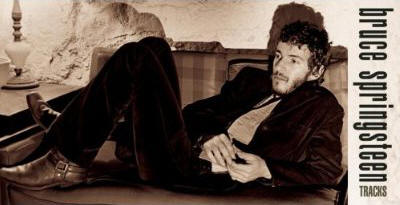Bruce. The Boss. Or Brrrrruuuuuuuuuuuuce! Tuesday was a notable anniversary for us Springsteen fanatics. Thirty-seven years earlier, Springsteen signed his recording deal with Columbia Records. Books could be written — and have been — about the impact that signing has had on the rock music.
 On May 2, 1972, Springsteen auditioned for Columbia’s John Hammond, who helped launch the careers of Billie Holiday, Count Basie, Aretha Franklin and Bob Dylan. Hammond also arranged a live audition by having Springsteen perform at the Gaslight, a Greenwich Village club, that night. The next day, Springsteen recorded a demo of 12 songs. Four of the recordings from that day — “Mary Queen of Arkansas,” “It’s Hard to Be a Saint in the City,” “Growin’ Up” and “Does This Bus Stop at 82nd Street?” — open Tracks, Springsteen’s 1998 compilation of unreleased tracks.
On May 2, 1972, Springsteen auditioned for Columbia’s John Hammond, who helped launch the careers of Billie Holiday, Count Basie, Aretha Franklin and Bob Dylan. Hammond also arranged a live audition by having Springsteen perform at the Gaslight, a Greenwich Village club, that night. The next day, Springsteen recorded a demo of 12 songs. Four of the recordings from that day — “Mary Queen of Arkansas,” “It’s Hard to Be a Saint in the City,” “Growin’ Up” and “Does This Bus Stop at 82nd Street?” — open Tracks, Springsteen’s 1998 compilation of unreleased tracks.
Springsteen’s first album, Greetings from Asbury Park, N.J., was released on January 9, 1973. Five of the nine tracks were songs Springsteen played at the demo. One that was not became Springsteen’s only #1 single — only it wasn’t his version. The Manfred Mann’s Earth Band version of “Blinded By The Light” hit number one in 1977. On VH1 Storytellers, Springsteen said the fact most people thought Manfred Mann used the word “douche” instead of “deuce” was the reason the song hit the top of the charts.
Despite being hailed as the next Bob Dylan and Greetings receiving critical praise, the album got no higher than 60 on the charts. Springsteen followed it in September 1973 with what, in my opinion, may be the greatest rock record ever made — The Wild, the Innocent & the E Street Shuffle. Despite high quality song writing and performance from end to end, no singles were released although it surpassed its predecessor by reaching 59th on the charts. Questions began being raised about whether Springsteen’s career was at an early end. But 1974 and 1975 would change that.
On May 9, 1974, Springsteen and the E Street Band performed at the Harvard Square Theater in Cambridge, opening for Bonnie Raitt. In the audience was Jon Landau, a music critic who wrote for Rolling Stone and the Real Paper. His review of the concert in the May 22 edition of the Real Paper has become legendary. “I saw rock and roll’s future and its name is Bruce Springsteen.” he wrote. “And on a night when I needed to feel young, he made me feel like I was hearing music for the very first time.” Not only did that buzz catch, before the year was out Landau became Springsteen’s agent.
Landau helped produce Born to Run and just two weeks before its release, Springsteen and the E Street Band performed 10 shows, two a night for five nights, at the Bottom Line in Greenwich Village. Those shows would be Springsteen’s breakthrough, being heavily attended by media and industry reps. In fact, Rolling Stone considers it one of the 50 moments that changed the history of rock music. Within two months, not only had Born to Run reached the top 10 on the Billboard album charts (peaking at number three), Springsteen was on the cover of both Time and Newsweek.
The rest, as they say, is history. Fittingly, this weekend the Rock and Roll Hall of Fame and Museum is going to host a Springsteen fanfest. A couple months ago, it also opened an exhibit called From Asbury Park to the Promised Land: The Life and Music of Bruce Springsteen. And 37 years after signing with Columbia, Springsteen remains with that record label.
I just told Michelle backstage that the reason I’m running for president is because I can’t be Bruce Springsteen.
Barack Obama, Oct. 16, 2008







